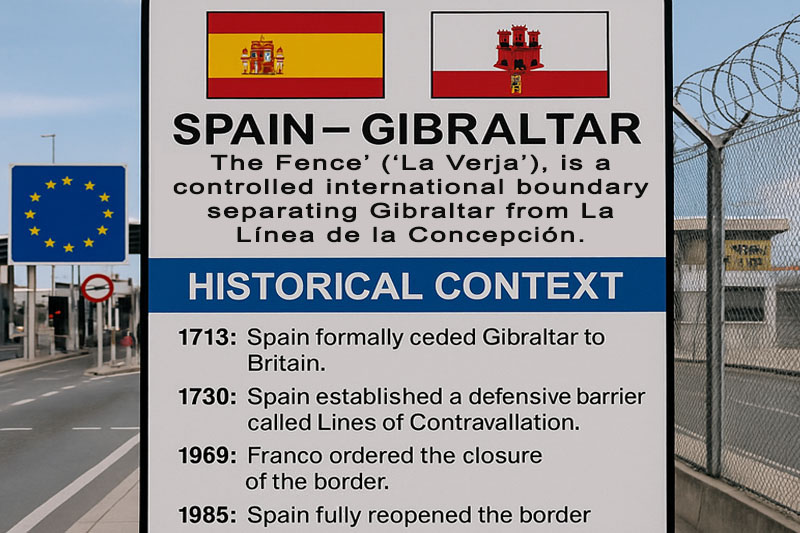The land border between Spain and Gibraltar, often referred to as ‘The Fence’ (‘La Verja’), is a controlled international boundary separating the British Overseas Territory of Gibraltar from La Línea de la Concepción in southern Spain.
The border runs east-west for 0.75 miles (1.2 km).

Historical Context
- 1713: Spain formally ceded Gibraltar to Britain under the Treaty of Utrecht.
- 1730: The Lines of Contravallation of Gibraltar were a set of fortifications built by the Spanish. They established a defensive barrier across the peninsula, with the aim of preventing any British incursions. In fact, the area where the lines once stood is now part of the Spanish town La Línea de la Concepción, which was named after them (‘La Línea’ means ‘The Line’ in Spanish).
- 8th June 1969: Francisco Franco ordered the closure of the border in response to the Gibraltar Constitution Order and the 1967 sovereignty referendum when Gibraltarians overwhelmingly voted to retain their links with Britain.
- 15th December 1982: The frontier was reopened to Spanish and Gibraltarian pedestrians.
- 5th February 1985: Spain fully reopened the border to support its entry into the European Economic Community (EEC).
Crossing the Border
- The border remains a busy checkpoint, with thousands of people crossing daily for work, tourism and trade.
- Residents of Gibraltar currently have red ID cards, which allow them to cross into Spain without needing their passport stamped or providing further justification for travel.
- As many as 15,000 people cross the border daily for work, the majority of whom are Spanish workers.
- On the Spanish side of the border, the Spanish Civil Guard and the Spanish National Police carry out customs and identity checks. Meanwhile, on the Gibraltar side, HM Customs Gibraltar and the Gibraltar Borders and Coastguard Agency handle border controls.
- Checks have sometimes caused long delays at the frontier. Following Brexit, British citizens who are not residents of Gibraltar generally have their passports stamped when entering and leaving Spain, as time spent in Gibraltar counts towards their Schengen 90/180-day limit. The Gibraltar Borders and Coastguard Agency provides a live camera feed of the queue at the Gibraltar Frontier, which is useful for planning your journey.
- There are customs rules governing what goods may be brought into or taken out of Gibraltar. Visit the HM Government of Gibraltar’s official website for up-to-date guidance.
- Maritime borders: The Gibraltar Port Authority manages the territorial waters of Gibraltar.
Current Political Situation
In June 2025, the UK, Spain, Gibraltar and the EU reached a breakthrough agreement on Gibraltar’s post-Brexit border status.
The deal eliminates physical checks at the Gibraltar–Spain land border, allowing smooth passage for goods and thousands of daily cross-border workers. At Gibraltar’s airport and port, two sets of checks will be conducted: Gibraltar authorities will perform their own checks, while Spanish authorities will carry out Schengen checks on behalf of the EU. However, Gibraltar will not join the Schengen area under the agreement.
The agreement includes a customs union between Gibraltar and the EU, as well as provisions on taxation, frontier workers’ rights, and a level playing field on state aid, labor, and environmental rules.
The UK retains full control of military operations in Gibraltar, including the RAF base, and sovereignty claims remain unchanged. A specific clause in the agreement protects UK sovereignty over Gibraltar.
The deal is designed to maintain economic stability, especially for the 15,000 frontier workers, and to avoid disruption from the EU’s Entry/Exit System (EES), due to be phased in from October 2025.
The agreement now awaits final legal drafting and ratification, with implementation expected by late 2025.
Last Updated on July 4, 2025 by Vanessa Kingwell

